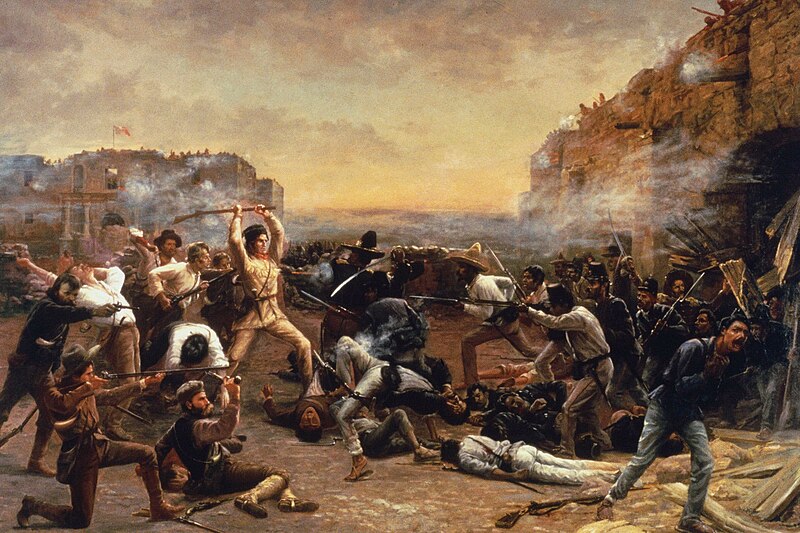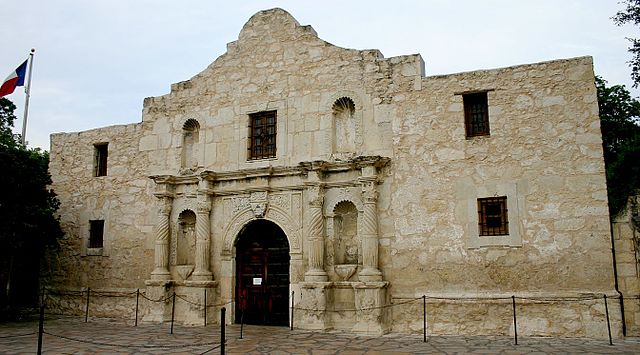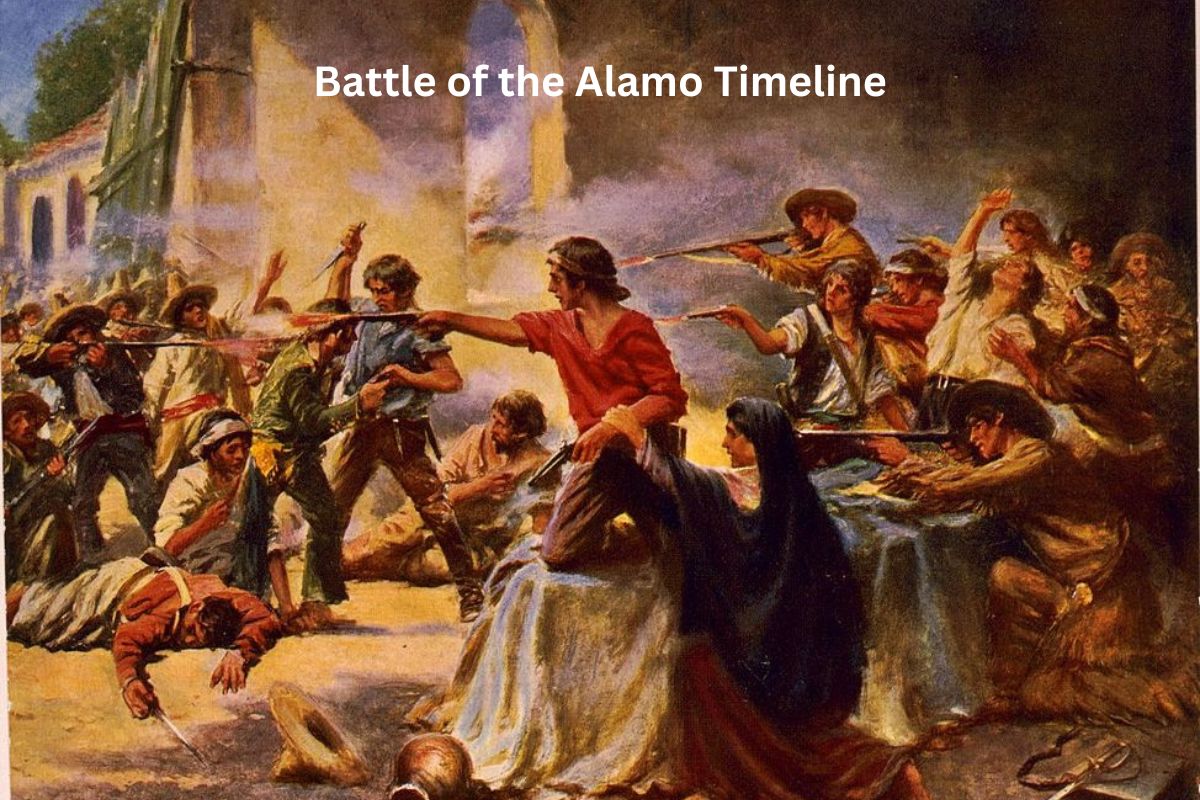The Battle of the Alamo, fought from February 23 to March 6, 1836, stands as a defining moment in American history and the Texas Revolution.
Located in the heart of San Antonio, the Alamo was a former mission and fortress where a small, determined group of Texian defenders, including iconic figures like Davy Crockett and Jim Bowie, made a valiant stand against overwhelming Mexican forces led by General Antonio López de Santa Anna.
The battle ended in tragedy, with the Texian defenders ultimately succumbing, but it became a symbol of courage and resilience that inspired the Texian forces to continue their fight for independence.
This brief overview sets the stage for a more detailed exploration of the Battle of the Alamo and its significance in the broader context of Texas history.
| Date | Event |
|---|---|
| September 1821 | Mexico gains independence from Spain. |
| Early 1835 | Tensions between Texan settlers and Mexican authorities escalate. |
| October 2, 1835 | The Texan settlers capture the town of Gonzales, often considered the start of the Texas Revolution. |
| October 13, 1835 | The Texan provisional government is established at Columbia. |
| October 28, 1835 | The Texan settlers capture San Antonio from Mexican forces. |
| November 1835 | Texans occupy the Alamo, a former mission in San Antonio. |
| December 1835 | Ben Milam leads Texan forces in an unsuccessful attempt to take San Antonio from Mexican troops. |
| February 23, 1836 | Mexican General Santa Anna and his army arrive in San Antonio and begin a siege of the Alamo. |
| February 24, 1836 | The famous “Thermopylae” message is sent from the Alamo, asking for reinforcements. |
| February 25, 1836 | James Fannin’s troops from Goliad attempt to march to the Alamo but are forced to turn back. |
| March 1, 1836 | The Texan delegates at Washington-on-the-Brazos declare independence, forming the Republic of Texas. |
| March 2, 1836 | Texas Declaration of Independence is signed. |
| March 3, 1836 | A small group of Texan reinforcements, including James Bonham, arrives at the Alamo. |
| March 5, 1836 | Colonel William Travis writes a famous letter appealing for more assistance. |
| March 6, 1836 | The Battle of the Alamo culminates in a brutal assault by Mexican forces. All Texan defenders are killed, including Jim Bowie, Davy Crockett, and William B. Travis. |
| March 27, 1836 | The Goliad Massacre occurs when Mexican forces execute nearly 350 Texan prisoners of war. |
| April 21, 1836 | The Texan army, led by General Sam Houston, defeats Santa Anna’s Mexican forces at the Battle of San Jacinto, effectively securing Texan independence. |
| May 14, 1836 | Santa Anna is captured and signs the Treaty of Velasco, recognizing Texas independence (though Mexico later disputed this). |
Timeline of the Battle of the Alamo
September 1821: Mexico gains independence from Spain
In 1821, Mexico successfully gained its independence from Spanish colonial rule. This event marked the end of Spanish domination in Mexico and established Mexico as a sovereign nation.
Early 1835: Tensions between Texan settlers and Mexican authorities escalate
By the early 1830s, a significant number of American settlers, known as Texians, had established themselves in the Mexican territory of Texas. Tensions began to rise due to differences in culture, language, and legal systems between these Anglo-American settlers and the Mexican government.
The Mexican government, led by General Antonio López de Santa Anna, sought to centralize power and enforce Mexican law in Texas, which led to opposition from the Texian settlers who desired greater autonomy and adherence to the Mexican Constitution of 1824.

October 2, 1835: The Texan settlers capture the town of Gonzales, often considered the start of the Texas Revolution
The conflict escalated on October 2, 1835, when Mexican soldiers attempted to retrieve a cannon that had been loaned to the Texians in Gonzales.
Texian settlers resisted the Mexican troops, and this skirmish is often considered the spark that ignited the Texas Revolution. The Texians successfully defended Gonzales and retained the cannon, which bore the words “Come and Take It.”
October 13, 1835: The Texan provisional government is established at Columbia
In response to the growing tensions and hostilities, Texian leaders gathered in the town of Columbia (now West Columbia) to form a provisional government for Texas. This marked a significant step toward organized resistance against Mexican rule.
The Consultation of 1835 resulted in the establishment of a provisional government, which included the appointment of Sam Houston as the commander-in-chief of Texian forces.
October 28, 1835: The Texan settlers capture San Antonio from Mexican forces
Texian forces, led by George Collingsworth, captured the Mexican garrison at Presidio La Bahía (Goliad) and then set their sights on San Antonio.
On October 28, 1835, Texian forces, under the command of Ben Milam, launched an attack on San Antonio, which was held by Mexican General Martín Perfecto de Cos.
After several days of fighting, Cos and his troops surrendered, and San Antonio came under Texian control. This victory was significant as it provided the Texians with a strategic stronghold, including the Alamo, which they would later defend during the famous Battle of the Alamo in 1836.

November 1835: Texans occupy the Alamo, a former mission in San Antonio
Following the Texian victory at San Antonio in October 1835, Texian forces occupied the Alamo, a former Spanish mission located in San Antonio. The Alamo became a crucial military post and symbol of Texian resistance.
The Texians, led by various commanders, including James C. Neill and James Bowie, fortified the Alamo in preparation for potential conflicts with Mexican forces.
December 1835: Ben Milam leads Texan forces in an unsuccessful attempt to take San Antonio from Mexican troops
In December 1835, Texian forces, under the leadership of Ben Milam, launched an assault on Mexican troops that had returned to San Antonio under General Martín Perfecto de Cos. The Texians aimed to fully secure the city.
The conflict became known as the Siege of Bexar, and it lasted from December 5 to December 9, 1835. Despite facing harsh weather conditions and determined Mexican resistance, the Texians eventually captured San Antonio.
February 23, 1836: Mexican General Santa Anna and his army arrive in San Antonio and begin a siege of the Alamo
In early 1836, Mexican General Antonio López de Santa Anna led a large Mexican army into Texas to suppress the Texian rebellion. Santa Anna arrived in San Antonio and laid siege to the Alamo on February 23, 1836.
The Texian defenders inside the Alamo, led by Colonel William B. Travis, Colonel James Bowie, and frontiersman Davy Crockett, realized they were vastly outnumbered and prepared for a prolonged defense.
February 24, 1836: The famous “Thermopylae” message is sent from the Alamo, asking for reinforcements
On February 24, 1836, Colonel William B. Travis penned a famous letter addressed “To the People of Texas and All Americans in the World.”
In the letter, Travis described the dire situation inside the Alamo and requested reinforcements, famously stating, “I shall never surrender or retreat.”
This letter became an iconic symbol of the Texian spirit and determination during the Texas Revolution.
February 25, 1836: James Fannin’s troops from Goliad attempt to march to the Alamo but are forced to turn back
In response to Travis’s plea for help, James Fannin, a Texian commander stationed at Goliad, attempted to march with reinforcements to the aid of the Alamo. However, Fannin’s troops encountered logistical challenges and poor weather conditions.
Fannin’s relief mission ultimately failed, and his forces were forced to turn back to Goliad without reaching the Alamo in time to provide assistance.
March 1, 1836: The Texan delegates at Washington-on-the-Brazos declare independence, forming the Republic of Texas
On March 1, 1836, the delegates of the Consultation of 1835 reconvened at Washington-on-the-Brazos and formally declared the independence of Texas from Mexico. This declaration marked the birth of the Republic of Texas.
March 2, 1836: Texas Declaration of Independence is signed
On March 2, 1836, the delegates at Washington-on-the-Brazos signed the Texas Declaration of Independence, outlining the grievances against Mexican rule and asserting Texas’s sovereignty as a separate nation.
March 3, 1836: A small group of Texan reinforcements, including James Bonham, arrives at the Alamo
As the Texian defenders inside the Alamo continued to hold out against the Mexican siege, a small group of reinforcements managed to break through Mexican lines and enter the Alamo on March 3, 1836. Among them was James Bonham, who brought news of the Texan declaration of independence.
March 5, 1836: Colonel William Travis writes a famous letter appealing for more assistance
On March 5, 1836, Colonel William B. Travis penned another famous letter from within the Alamo. In this letter, he addressed it “To the People of Texas & all Americans in the world” and urgently called for reinforcements, stating that the situation inside the Alamo had become desperate.
March 6, 1836: The Battle of the Alamo culminates in a brutal assault by Mexican forces. All Texan defenders are killed, including Jim Bowie, Davy Crockett, and William B. Travis
The climactic Battle of the Alamo took place from February 23 to March 6, 1836, when Mexican General Santa Anna launched a final assault on the Alamo.
The Texian defenders, numbering around 180 to 250, faced overwhelming odds as Santa Anna’s forces, estimated at over 1,800 soldiers, attacked.
Despite their fierce resistance, the Texian defenders were ultimately overwhelmed, and the Alamo fell to Mexican forces on March 6, 1836. Among those killed were prominent figures such as Jim Bowie, Davy Crockett, and William B. Travis.
March 27, 1836: The Goliad Massacre occurs when Mexican forces execute nearly 350 Texan prisoners of war
In the wake of the fall of the Alamo, General Santa Anna continued his campaign against Texian rebels. One of the most notorious events during this period was the Goliad Massacre on March 27, 1836.
After the Texian surrender at the Battle of Coleto Creek, Colonel James Fannin and nearly 350 Texian prisoners of war were executed by Mexican forces under Santa Anna’s orders. This brutal act further galvanized support for the Texian cause and fueled their determination to achieve independence.
April 21, 1836: The Texan army, led by General Sam Houston, defeats Santa Anna’s Mexican forces at the Battle of San Jacinto, effectively securing Texan independence
Following the fall of the Alamo and the Goliad Massacre, the Texian cause seemed bleak. However, Texian forces, under the command of General Sam Houston, regrouped and prepared for a decisive confrontation with Mexican General Santa Anna’s army.
On April 21, 1836, the two forces met at the Battle of San Jacinto, near the San Jacinto River. The Texian army, numbering around 900 men, launched a surprise attack on the Mexican camp during siesta time. The battle lasted only 18 minutes but resulted in a resounding Texian victory.
During the battle, Texian soldiers shouted the rallying cry “Remember the Alamo!” as they sought revenge for the deaths of those who had perished at the Alamo and Goliad. General Santa Anna himself was captured the following day, effectively ending the main military campaign against the Texian rebels.
May 14, 1836: Santa Anna is captured and signs the Treaty of Velasco, recognizing Texas independence (though Mexico later disputed this)
After his capture following the Battle of San Jacinto, General Santa Anna was brought before General Sam Houston. In captivity, Santa Anna agreed to negotiate with the Texians.
On May 14, 1836, Santa Anna signed two documents known as the Treaties of Velasco. The public treaty acknowledged the defeat of Mexican forces and the independence of Texas, while a secret treaty detailed the terms of Santa Anna’s release and his promise to lobby the Mexican government to recognize Texan independence.
While the Treaties of Velasco seemingly secured Texan independence, the Mexican government later repudiated the agreements, leading to ongoing tensions and disputes between Texas and Mexico.
